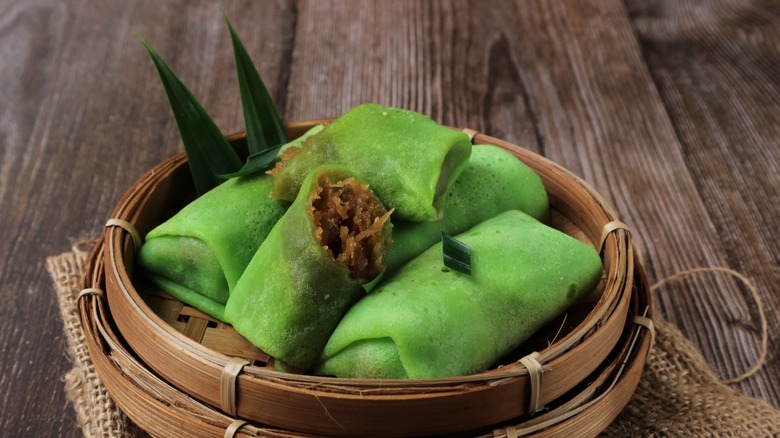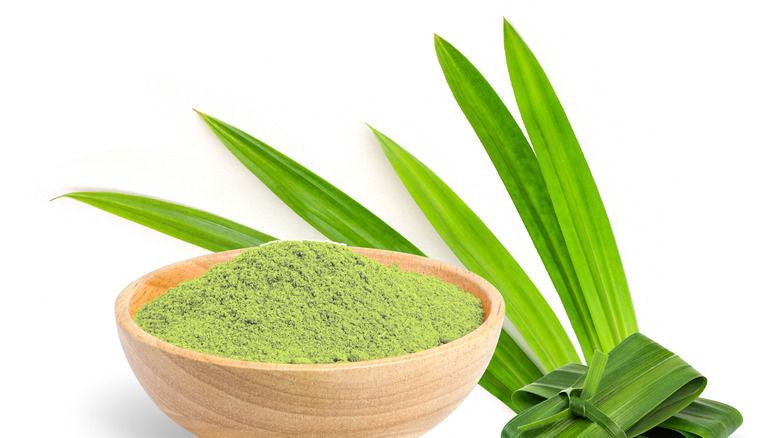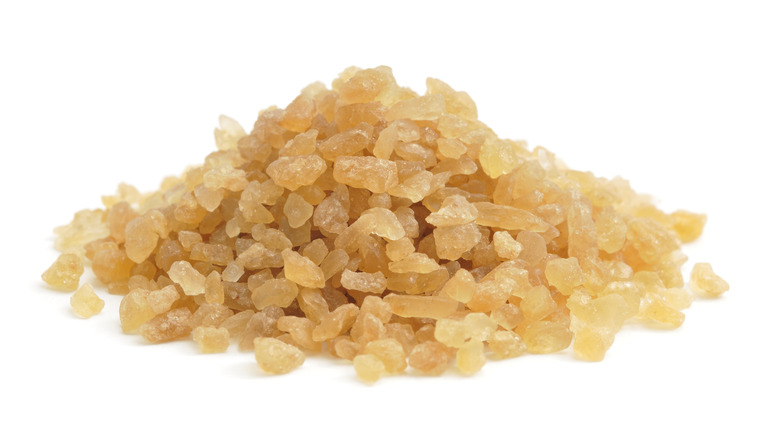Dadar Gulung: The Indonesian Coconut Pancake You Need To Try
Imagine a jade-colored Southeast Asian crepe: A spongy, soft, burrito-shaped pancake filled with a sweet blend of grated coconut and palm sugar. That's dadar gulung, the Indonesian snack that's especially popular in Java. The good news is that you don't need any specialist skills to make dadar gulung at home. It does require one magical (yet easy to obtain) ingredient that will not only make the whole excursion worthwhile but also open doors to new culinary horizons: pandan.
At its heart, dadar gulung has two components: a batter and a filling. The batter is made with flour, eggs, water, coconut milk, and salt. The filling is basically shredded coconut and palm sugar. The batter is cooked in a hot pan until just set when the filling is added, and then the pancake is folded over to make a rectangular envelope of deliciousness. Dadar gulung batter also contains one more ingredient: fragrant green pandan leaves. They're what gives these Indonesian pancakes their bright green color and subtly sweet, floral flavor.
The vanilla of Southeast Asian cooking
Pandanus amaryllifolius, also known as screw pine, is a tropical plant with long, blade-shaped leaves that are used in dishes both savory and sweet, similar to how you might use vanilla. (The plant also produces a deep orange-colored, pine cone-shaped fruit that is both nutritious and delicious.) Pandan leaves, which become fragrant when crushed, are used in a variety of ways: They're often knotted and placed in a pot of boiling rice for aroma and color; boiled to make a refreshing drink; used to wrap foods like an herbaceous aluminum foil; or turned into a paste. Oh, and they're also used as air fresheners, cockroach repellents, and Ayurvedic medicinal treatments for various health complaints.
Because pandan acts as both a flavoring agent and food coloring in dadar gulung, there's really no substitute for it. Luckily, pandan is widely available in many different forms: You can buy pandan leaves fresh, frozen, or dried, or turned into extracts, powders, and pastes. Once you discover it, you'll understand why pandan is universally loved in Thai, Malaysian, and Japanese cuisine.
Palm sugar, a sweetener you need to know
The other authentic dadar gulung ingredient is palm sugar, a popular Southeast Asian sweetener. Although both are produced from the sap of flowers from certain palm trees, palm sugar is distinct from coconut sugar and vastly different from cane sugar. Palm sugar is less refined and less sweet than cane sugar — with a correspondingly lower glycemic index — and has a complex flavor that more closely resembles brown sugar. Palm sugar is available in Asian markets (and online) and goes by various names: Indians call it jaggery, Thais refer to it as nam tan pip, and Malaysians know it as gula melaka. If you don't have palm sugar immediately to hand, your dadar gulung won't be ruined. Coconut sugar or brown sugar will make a fine, if less complex, substitute.
So that's the skinny on dadar gulung, the Indonesian coconut pancake you need in your life. They're easy to make, appetizingly green, and soft, fragrant, and sweet. Even better, they can be your gateway to the delights of pandan leaves and palm sugar. What's not to love?


